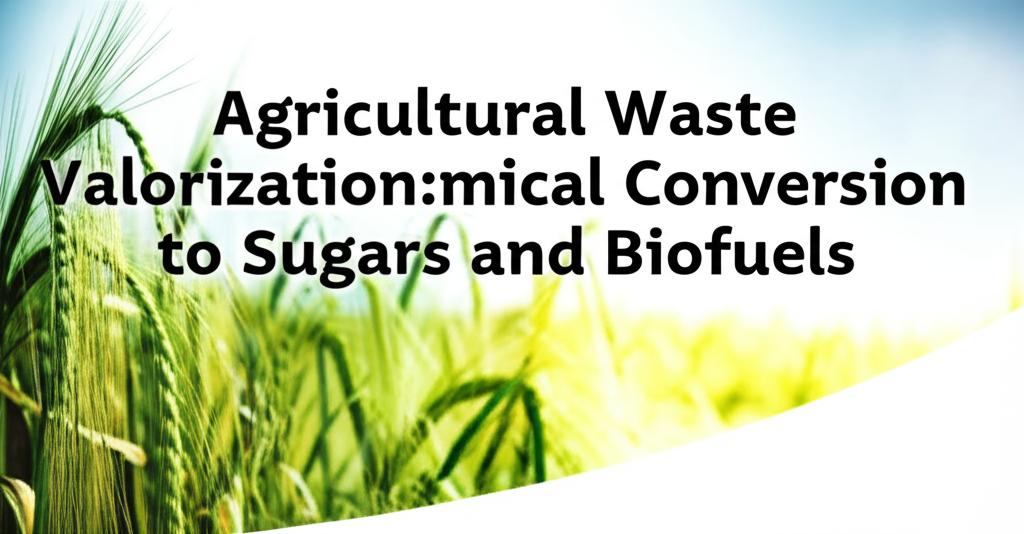Agricultural waste, a vast and often underused resource, offers a significant opportunity to produce sustainable biofuels and valuable biochemicals. This conversion process, known as valorization, plays a crucial role in reducing our reliance on fossil fuels, mitigating greenhouse gas emissions, and addressing waste management challenges. Biochemical conversion, utilizing microorganisms and enzymes, is a key pathway in this endeavor, breaking down complex organic matter into simpler sugars that can then be transformed into a range of biofuels.
The Core of Biochemical Conversion: From Waste to SugarsThe primary components of agricultural waste, such as crop residues (straws, stalks, leaves), animal manure, and agro-industrial by-products (husks, bagasse), are rich in lignocellulosic biomass. This biomass consists mainly of cellulose, hemicellulose, and lignin. Through biochemical processes, cellulose and hemicellulose can be hydrolyzed – broken down – into fermentable sugars like glucose and xylose. These sugars are the essential building blocks for biofuel production.
Key Biochemical Conversion Processes:- Enzymatic Hydrolysis: This process uses specific enzymes, such as cellulases and xylanases, to break down cellulose and hemicellulose into simple sugars. Significant research is focused on improving enzyme efficiency and reducing their cost, as this is a critical step in the overall economic viability of biofuel production. Immobilizing enzymes on nanoparticles is a promising approach to enhance their stability and allow for easier recovery and reuse.
- Microbial Fermentation: Once simple sugars are obtained, various microorganisms (bacteria, yeast, fungi) are used to ferment these sugars into biofuels.
Bioethanol: Yeast is commonly used to ferment sugars into bioethanol, a widely used biofuel that can be blended with gasoline.
Biobutanol: Certain bacteria can convert sugars into biobutanol, which has a higher energy density than ethanol and can be a "drop-in" biofuel for existing infrastructure.
Biogas (Biomethane): Anaerobic digestion is a process where microorganisms break down organic materials in the absence of oxygen, producing biogas, which is primarily methane and carbon dioxide. Biogas can be used for heating, electricity generation, or upgraded to biomethane for use as a vehicle fuel. Europe has seen a significant increase in biomethane production in recent years.
Biohydrogen: Some microorganisms, including certain types of microalgae, can produce hydrogen gas through photobiological processes or fermentation.
Pretreatment: A Critical First StepLignocellulosic biomass has a recalcitrant structure, meaning it's resistant to breakdown. Therefore, a pretreatment step is usually necessary before biochemical conversion. Pretreatment aims to disrupt the complex structure of lignin, cellulose, and hemicellulose, making the cellulose and hemicellulose more accessible to enzymes. Various pretreatment methods exist, including:
- Physical methods: Milling, grinding, and extrusion.
- Chemical methods: Using acids, alkalis, or organic solvents. Dilute acid pretreatment is common for optimizing sugar yields.
- Physicochemical methods: Steam explosion, ammonia fiber explosion/expansion (AFEX).
- Biological methods: Using microorganisms or their enzymes (ligninolytic enzymes) to degrade lignin. While eco-friendly and requiring low energy, biological pretreatments can be slow. Advanced biotechnologies are being explored to enhance the efficiency of lignin-degrading enzymes.
- Nanobiotechnology: The use of nanomaterials and nanobiocatalysts is an emerging area. Nanoparticles can be used to immobilize enzymes, increasing their efficiency, stability, and recyclability, thereby reducing costs. Nanomaterials are also being explored for direct pretreatment of biomass and to enhance microbial activity during fermentation.
- Co-culturing Techniques: Employing multiple types of microorganisms together (co-cultures) in fermentation processes can lead to more efficient conversion and the production of a wider range of biofuels like biodiesel, bioethanol, and biobutanol.
- Integrated Biorefineries: The concept of a biorefinery involves using all components of the agricultural waste to produce a variety of products, including biofuels, biochemicals (like phenols, vanillin, organic acids), and biopolymers. This integrated approach improves the overall economic viability and sustainability of the valorization process.
- Microbial Fuel Cells (MFCs): This technology uses electrogenic bacteria to directly convert the chemical energy in organic waste into electricity. MFCs can simultaneously treat waste and generate power.
Despite significant progress, several challenges remain in the widespread adoption of agricultural waste for biofuel production via biochemical routes:
- Feedstock Logistics and Variability: The collection, transportation, and storage of bulky agricultural waste can be costly. The composition of waste can also vary significantly depending on the source, season, and harvesting methods, which can affect conversion efficiency.
- Cost of Enzymes and Pretreatment: Pretreatment processes can be energy-intensive, and the cost of enzymes for hydrolysis remains a significant barrier.
- Conversion Efficiency and Yields: Improving the efficiency of converting sugars into biofuels and increasing the final product yields are crucial for economic competitiveness. For instance, while butanol is a promising advanced biofuel, its production yield needs substantial improvement.
- Scale-up and Commercialization: Transitioning from laboratory-scale research to commercial-scale production presents technical and economic hurdles.
- Sustainability Assessment: Thorough life-cycle assessments are needed to ensure the overall environmental benefits and sustainability of these processes, considering factors like land use, water consumption, and nutrient cycling.
Future research will likely focus on developing more cost-effective and efficient pretreatment methods, engineering more robust and productive microbial strains, optimizing enzyme cocktails, and improving the design of integrated biorefineries. The goal is to make the biochemical conversion of agricultural waste a truly competitive and sustainable route for producing sugars and biofuels, contributing to a circular bioeconomy and a greener energy future.

